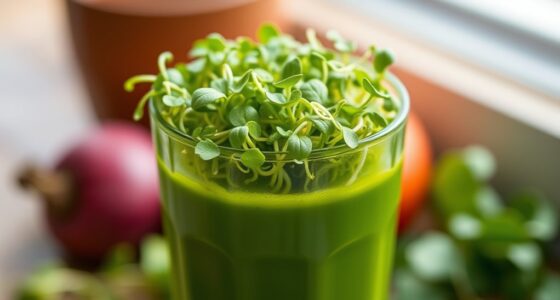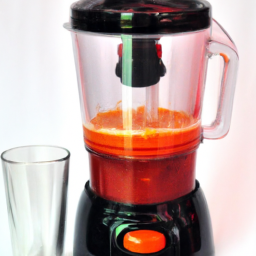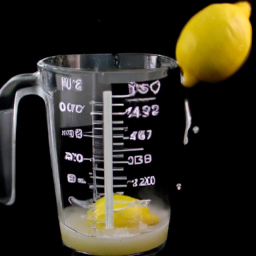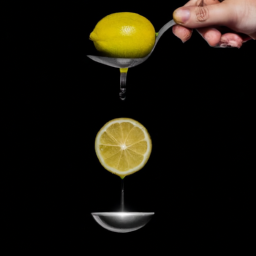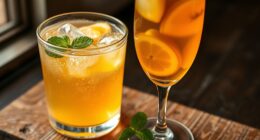Limes are a great addition to any kitchen, ideal for making a refreshing margarita or adding a tangy flavor to your marinade. Have you ever thought about how much juice you can extract from just one lime?
As someone who loves to cook and experiment in the kitchen, I decided to dive into the science behind lime juice production and share my findings.
Several factors can affect how much juice one lime makes, including the lime’s size, ripeness, and the type of juicing tool used. It can be frustrating to buy a bag of limes only to find that they yield minimal juice. However, with the right techniques and tools, you can maximize your lime juice output and add a burst of citrus to your favorite dishes.
Join me as we explore the art of juicing limes and discover how to get the most out of this flavorful fruit.
Key Takeaways
- Slightly soft, bright green limes are best for juicing.
- Tools for juicing include squeezer, electric juicer, fork, handheld reamer, and blender.
- Proper lime selection is crucial for optimal juicing results.
- Expect 1-2 tablespoons of juice per lime.
Factors Affecting Lime Juice Production
Let’s talk about what factors can affect how much juice your lime yields! First and foremost, the ripeness of the lime will have a significant impact on how much juice it produces. A lime that’s fully ripened will be juicier and more flavorful than one that’s underripe or overripe.
When selecting limes, look for ones that’re slightly soft to the touch and have a bright green skin. These’ll typically yield the most juice.
Another factor to consider is the juicing method you use. Hand squeezing a lime’ll yield less juice than using a juicer or a citrus press. A juicer’ll extract more juice by breaking down the lime’s fibers, while a citrus press’ll squeeze the lime more thoroughly than you can by hand.
By using the right tools and techniques, you can maximize the amount of juice you get out of each lime. Now, let’s move on to discussing the tools you’ll need for juicing limes.
Tools for Juicing Limes
Using a citrus squeezer, you’ll easily extract the tangy liquid from these small green fruits. Here are some tools and techniques I recommend for juicing limes:
-
Lime squeezer: This handheld tool is specifically designed to extract juice from limes and other small citrus fruits. It works by pressing the lime half against a ridged surface and squeezing the handles together to extract the juice.
-
Electric juicer: If you’re juicing a large quantity of limes, an electric juicer can save time and effort. Simply cut the limes in half and place them in the juicer, which will automatically extract the juice.
-
Fork: In a pinch, a fork can be used to extract lime juice. Cut the lime in half and use the fork to twist and press the lime against a bowl or container to extract the juice.
-
Handheld reamer: Similar to a lime squeezer, a handheld reamer can be used to extract juice from limes and other citrus fruits. Simply insert the reamer into the lime half and twist to extract the juice.
-
Blender: For recipes that require a large amount of lime juice, such as marinades or dressings, a blender can be used to extract the juice. Cut the limes into quarters and blend with a small amount of water, then strain the liquid through a fine mesh sieve.
Now that you have your tools ready, let’s move on to preparing the limes for juicing.
Preparing Limes for Juicing
Before juicing limes, it’s important to wash them thoroughly to remove any dirt or debris that may be on the skin. Proper lime selection is also crucial for optimal juicing results. Choose limes that are firm and heavy for their size, with smooth and shiny skin. Avoid limes that feel dry or have soft spots, as they may not yield as much juice.
When preparing limes for juicing, start by cutting off the ends with a sharp knife. Then, slice the lime in half lengthwise. To get the most juice out of the lime, use squeezing techniques that involve applying pressure to the center of the fruit. You can also use a citrus juicer to extract the juice.
If you prefer pulp-free juice, use a small spoon or citrus reamer to remove the pulp before juicing. These techniques will help you get the most juice out of your limes and ensure that your drinks and dishes have the perfect balance of acidity.
Next, let’s explore some techniques for juicing limes.
Techniques for Juicing Limes
To get the most out of your limes, you’ll want to try different squeezing techniques that involve applying pressure to different parts of the fruit. This will help increase juicing efficiency and ensure that you get as much juice as possible from each lime.
Here are three techniques you can try:
-
Cut the lime in half crosswise and then squeeze each half with your hand. This technique is great for small to medium-sized limes and allows you to control the amount of pressure you apply.
-
Use a citrus juicer to extract the juice from the lime. This technique is ideal if you have larger limes or need to juice a lot of them quickly. The juicer will apply pressure evenly across the entire fruit, which can help you get more juice out of each lime.
-
For maximum juicing efficiency, try rolling the lime on a hard surface before cutting it open. This will help break down the membranes inside the fruit and release more juice. This technique is especially helpful for juicing larger or less ripe limes.
When it comes to measuring lime juice, you’ll want to make sure that you have an accurate way to do so.
Measuring Lime Juice
When it comes to measuring lime juice, there are a few key points to keep in mind. First, it’s important to understand the difference between measuring by volume and measuring by weight.
Additionally, it’s useful to know how to convert the number of limes needed to a specific amount of juice. Finally, being able to adjust recipes based on the amount of juice you have on hand can help you make the most of your lime juice.
Volume vs. Weight
Imagine you’re holding a lime in your hand – did you know that the amount of juice it produces is measured by volume, not weight? When it comes to measuring lime juice, volume conversion is the key factor. This means that the volume of the lime juice is measured in milliliters (mL), rather than its weight in grams (g).
In order to convert the weight of a lime to its volume, we have to consider the density comparison between the two. Here are three important things to keep in mind when comparing volume and weight for measuring lime juice:
- Density: the density of lime juice is approximately 1.03 g/mL, which means that 1 milliliter of lime juice weighs 1.03 grams.
- Precision: using a precise measuring tool, such as a graduated cylinder, is essential to accurately measure the volume of lime juice.
- Variability: the amount of juice that a lime produces can vary based on its size, ripeness, and freshness, which can affect the volume of juice extracted.
Now that we understand the importance of volume conversion and density comparison when measuring lime juice, let’s explore how to convert limes to juice.
Converting Limes to Juice
Now that we’ve got our hands on some fresh limes, let’s squeeze them into a tangy, citrusy elixir. But how much juice can we expect to get from one lime? The answer is about 1-2 tablespoons of lime juice per lime, depending on its size and ripeness.
To extract the most juice from your limes, try rolling them on a hard surface before cutting them in half and juicing them. This helps to break down the membranes and release more juice. You can also use a citrus juicer or a hand-held reamer to get the most out of your limes.
And if you don’t have any limes on hand, you can substitute with lemon juice, vinegar, or even white wine in some recipes.
With this knowledge of lime juice extraction techniques, we can adjust our recipes accordingly to get the perfect balance of tangy flavor.
Recipe Adjustments
To get the perfect balance of tangy flavor in your recipe, you’ll need to make adjustments based on the amount of lime juice you want to use. If you don’t have enough limes to make the desired amount of juice, there are recipe substitutions and lime juice alternatives you can use.
For example, you can use lemon juice as a substitute for lime juice in most recipes. However, keep in mind that lemon juice has a stronger flavor than lime juice, so you may need to use less of it to achieve the same level of tanginess.
Another alternative to lime juice is bottled lime juice, which can be found in most grocery stores. This is a convenient option if you don’t have fresh limes on hand or if you need a larger quantity of juice. However, bottled lime juice may not have the same level of freshness and flavor as freshly squeezed lime juice, so you may need to adjust the amount you use to achieve the desired flavor in your recipe.
When you have finished making adjustments to your recipe and have the perfect amount of lime juice, you may be wondering what to do with any leftover juice. In the next section, I’ll explain the best ways to store lime juice to ensure it stays fresh and flavorful for future use.
Storing Lime Juice
Preserve that precious lime juice by promptly putting it in an airtight container to prolong its potency. Lime juice has a limited shelf life, particularly when exposed to air and light. If stored properly, lime juice can last for up to a week in the refrigerator. It is important to choose the right container for storing lime juice. Glass containers, such as mason jars or glass bottles, are ideal for storing lime juice as they do not react with the acid in the juice. Plastic containers or bags can also be used, but they may not be as effective in preventing oxidation.
To further extend the shelf life of lime juice, consider freezing it. Lime juice can be frozen in ice cube trays, then transferred to a freezer-safe container once frozen. This allows for easy portioning and use in future recipes. When using frozen lime juice, it is important to thaw it in the refrigerator and use it promptly.
Using lime juice in cooking is an excellent way to add acidity and brightness to dishes. But before we delve into that, let’s first explore the benefits of using fresh lime juice in cooking.
Using Lime Juice in Cooking
Enhance the flavor profiles of your dishes by incorporating fresh lime juice into your cooking. It adds a zesty and tangy kick to any recipe. Lime juice is packed with nutrients such as vitamins C and A, flavonoids, and antioxidants, making it a healthy and flavorful addition to any meal. Lime juice also has antibacterial properties that can help prevent foodborne illnesses. Therefore, it’s a great ingredient to use in raw dishes like ceviche or salsa.
There are different types of lime juice available in the market, each with its own distinct flavor and acidity level. For instance, key lime juice has a strong and tart flavor that’s perfect for making pies and desserts. On the other hand, Persian lime juice has a milder taste and is commonly used in cooking savory dishes like rice, soups, and stews. By experimenting with different types of lime juice and incorporating them into your recipes, you can create unique and delicious flavor combinations. These flavor combinations will impress your guests and elevate your cooking to the next level.
Incorporating lime juice into your cooking is just one way to enjoy the benefits of this versatile citrus fruit. In the next section, we’ll explore how to use lime juice in beverages to create refreshing and flavorful drinks.
Using Lime Juice in Beverages
I love using lime juice in my beverages! Not only does it add a zesty flavor, but it also has health benefits.
Lime juice is commonly used in cocktails and mocktails, as well as infused water and tea. Its high vitamin C content can help boost the immune system, while its antioxidants can help fight against free radicals in the body.
Cocktails and Mocktails
If you’re making a delicious cocktail or mocktail, one lime can provide enough juice to give your drink a zesty kick. Lime juice is a popular ingredient in many cocktails and mocktails due to its tart and acidic flavor that pairs well with a variety of other ingredients.
Lime juice can also be used to balance out the sweetness of sugary drinks, and it can add a refreshing and bright taste to any beverage. When using lime juice in cocktails or mocktails, it’s important to experiment with flavor combinations and garnishes to create a unique and enjoyable drink.
Some popular combinations include lime juice with rum, tequila, or gin, and garnishes such as mint or jalapeño can add an extra layer of flavor. With just one lime, you can elevate the taste of your beverage and impress your guests with your mixology skills.
Moving on to infused water and tea, there are many ways to incorporate lime juice into these drinks as well.
Infused Water and Tea
Discover new ways to add a zesty twist to your infused water and tea by incorporating the refreshing tartness of lime. Infused water has become increasingly popular for its hydrating and detoxifying benefits. By adding lime to your water, you not only enhance the flavor but also boost its nutritional value.
Lime contains vitamin C, which acts as a natural antioxidant, protecting your cells against free radicals that can cause damage. Additionally, lime has citric acid, which promotes healthy digestion and can help prevent kidney stones.
When it comes to tea infusions, lime pairs well with a variety of flavors. For a tropical twist, try infusing your tea with lime and pineapple. If you’re looking for a classic combination, lime and ginger make a perfect match. Lime can also add a refreshing twist to green tea, which is known for its many health benefits, including reducing the risk of heart disease and stroke.
By adding lime to your tea, you not only enhance the flavor but also reap the benefits of this citrus fruit. As we explore the health benefits of lime, it’s important to note that incorporating lime into your infused water and tea is just one small step towards a healthier lifestyle.
Health Benefits
I hope you enjoyed learning about infused water and tea! Now, let’s delve into the nutritional value and immune-boosting properties of lime juice.
Limes are a great source of vitamin C, which is a powerful antioxidant that helps protect our cells from damage caused by free radicals. In fact, one lime contains about 32% of our daily recommended intake of vitamin C.
This vitamin also helps support our immune system by stimulating the production of white blood cells that fight off infection and disease.
In addition, limes contain other beneficial nutrients such as potassium, folate, and flavonoids which have anti-inflammatory and anti-cancer properties.
So next time you’re looking for a healthy boost, consider adding lime juice to your meals or drinks! Speaking of which, lime juice can add a refreshing zing to many recipes.
From marinades and dressings to cocktails and desserts, the possibilities are endless. So let’s explore some delicious ways to incorporate lime juice into your culinary creations!
Recipes Featuring Lime Juice
You’ll love the zesty flavor that a single lime can add to your favorite recipes, and did you know that on average, one lime produces about 2 tablespoons of juice?
Lime juice can be used as a substitute for vinegar or other acidic ingredients in recipes, and it also works great as a marinade for meats and seafood. Adding lime juice to your dishes can elevate the flavor profile and give a refreshing twist to your meals.
Try using it in dressings, sauces, and even desserts for a tangy kick. But before you start squeezing those limes, make sure to read on for some tips and tricks for juicing them effectively.
Tips and Tricks for Juicing Limes
When it comes to juicing limes, there are a few key tips and tricks that can help you get the most juice out of your fruit. First and foremost, it’s important to select limes that are ripe and juicy.
Additionally, proper storage can help prolong the life of your limes and ensure they’re ready for use when you need them. Once you have your limes ready, it’s important to clean your juicing tools thoroughly to ensure maximum juice extraction.
Buying and Storing Limes
To get the most juice out of your limes, make sure to choose ones that are firm and heavy for their size. When choosing fresh limes, look for those with smooth, unblemished skins. Avoid overripe limes as they’ll be dry and have less juice.
Quality limes should have a bright green color and no soft spots. Proper storage is also key to keep your limes fresh and juicy. Store them in a cool, dry place away from direct sunlight.
Limes can also be stored in the refrigerator for up to two weeks. When refrigerated, they’ll be easier to juice and will yield more juice. Now that we’ve covered choosing fresh limes and proper storage, let’s move on to getting the most juice out of your limes.
Getting the Most Juice
Now that we have our limes, it’s time to get the most juice out of them. The amount of juice yield you can get from a lime can vary depending on several factors, such as its ripeness, size, and juicing techniques used.
To demonstrate this, here’s a table that shows the estimated juice yield of an average-sized lime using different juicing techniques:
| Juicing Technique | Estimated Juice Yield |
|---|---|
| Hand-squeezing | 1-2 tablespoons |
| Manual juicer | 2-3 tablespoons |
| Electric juicer | 4-5 tablespoons |
| Citrus press | 4-6 tablespoons |
As you can see, using an electric juicer or citrus press can give you the most juice yield, but hand-squeezing and manual juicing can still be effective if you don’t have the equipment. It’s also important to note that if you want to get the most juice out of your limes, make sure they are at room temperature and roll them on a hard surface before cutting to break up the juice sacs.
Now that we know how to get the most juice out of our limes, it’s important to clean our juicing tools properly to prevent any bacteria growth.
Cleaning Your Juicing Tools
Congratulations, you’ve successfully juiced your limes! But before you start celebrating, let’s talk about the not-so-fun part: cleaning your juicing tools. Cleaning efficiency is crucial if you want to extend the lifespan of your juicing tools and ensure they work at their best.
Proper maintenance is also necessary to prevent any bacterial growth or contamination that may affect the quality of your juice.
To clean your juicing tools, start by disassembling them and rinsing the parts under warm water. Use a brush with soft bristles to remove any leftover pulp or seeds that may be stuck in the crevices.
If there are any stubborn stains, you can soak the parts in a mixture of warm water and vinegar for a few minutes before scrubbing them again. Make sure to dry the parts completely before reassembling them.
By following these steps, you can maintain the cleaning efficiency of your juicing tools and ensure that they work optimally every time you use them.
Frequently Asked Questions
How long does it take for a lime to produce juice after it has been cut?
After cutting a lime, it takes mere seconds for juice to be extracted with the best lime juicers. The yield of lime juice varies depending on the size and ripeness of the lime, but can range from 1-2 tablespoons.
Can lime juice be frozen for later use?
I’ve found that lime juice can be frozen for up to 6 months, but it may lose some flavor. Optimal storage is in an airtight container. Freezing options include ice cube trays or freezer bags.
What are some common mistakes people make when juicing limes?
When juicing limes, it’s important to use the right technique to extract the maximum amount of juice. Avoid squeezing too hard or using a dull juicer. Also, different lime varieties may have varying levels of acidity and sweetness.
Are there any health benefits to drinking lime juice?
Drinking lime juice has numerous health benefits, including aiding digestion, boosting immunity, and reducing inflammation. Lime juice can be used in a variety of recipes, from marinades to cocktails, and adds a tangy, refreshing flavor to any dish.
What is the difference between fresh lime juice and bottled lime juice in terms of taste and nutritional value?
Fresh lime juice has a distinct, tangy taste due to its high vitamin C content. Bottled lime juice may lack flavor and have added preservatives. Nutritional content varies, with fresh lime juice containing more antioxidants and nutrients.
Conclusion
In conclusion, I’ve found that one lime can produce approximately 1-2 tablespoons of juice. However, this can vary depending on factors such as the size and ripeness of the lime, as well as the juicing technique used.
Despite the variability in juice production, limes are a versatile and flavorful addition to many dishes and beverages. From refreshing limeade to zesty guacamole, there are countless ways to incorporate lime juice into your culinary creations.
By using the proper tools and techniques, you can maximize the amount of juice extracted from each lime and enjoy the full potential of this citrus fruit. So go ahead, squeeze a lime and add a burst of flavor to your next dish or drink.
As the famous saying goes, when life gives you limes, make something delicious!
Ilana has been a vegan for over 10 years. She originally made the switch for health reasons, but soon found herself becoming more and more passionate about the ethical and environmental implications of a vegan lifestyle. Ilana is the author of The Graceful Kitchen, a blog all about veganism. She loves to cook up delicious and nutritious vegan meals, and share her recipes with others who are interested in leading a cruelty-free life. Ilana is also a strong advocate for using whole foods as the foundation of a healthy diet, and believes that going vegan is one of the best ways to achieve this.



